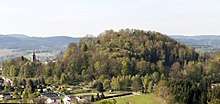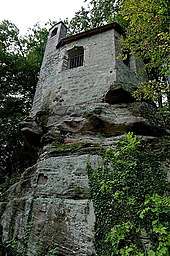Château de Bruyères
The château de Bruyères is a ruined castle located in the town of Bruyères, in the Vosges department of eastern France.

History
The castle was built during the 10th century by the Duke of Lorraine, on a small hill. According to the local history, the site has been fortified in the 6th century by a son of Clodio, King of the Franks.
Around 1178, Frederick I, Duke of Lorraine took over the castle and several domains and returned it to his elder brother, Simon II, Duke of Lorraine after the Treaty of Ribemont (1179).[1].
It is said that Emperor Henri VI stayed there for hunting, in 1196.
The castle was destroyed by fire in 1715.
Description

The castle had a rectangular shape; in the centre, the keep was protected by two enceintes. One of the two entrances was fortified by a large tower, named la Cabée.
The chapel, dedicated to Saint Blaise, is the last building still standing, in the east of the plateau.
See also
References
- Joseph Barre (1748). Histoire générale de l'Allemagne. 5. Paris. p. 309-310. Retrieved 10 December 2019.
- "Les ducs de Lorraine au Moyen Age". metreya.blog.lemonde.fr (in French). Archived from the original on 20 September 2008. Retrieved 10 December 2019.
External links
- Château de Bruyères at Bruyères website (in French)